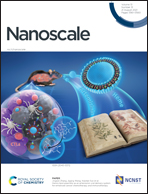Protein–biomolecule interactions play a major role in shaping corona proteome: studies on milk interacted dietary particles†
Abstract
Despite the significance of surface absorbed proteins in determining the biological identity of nanoparticles (NPs) entering the human body, little is known about the surface corona and factors that shape their formation on dietary particles used as food additives. In this study, food grade NPs of silica and titania and their food additive counterparts (E551 and E171) were interacted with milk proteins or with skimmed milk and the levels of protein adsorption were quantified. Characteristics of proteins correlating with their level of adsorption to NPs were determined using partial least squares regression analysis. Results from individual protein–particle interactions revealed the significance of factors such as zeta potential, hydrophobicity and hydrodynamic size of particles, and protein characteristics such as the number of beta strands, isoelectric points, the number of amino acid units (Ile, Tyr, Ala, Gly, Pro, Asp, and Arg), and phosphorylation sites on their adsorption to particles. Similar regression analysis was performed to identify the characteristics of twenty abundant and enriched proteins (identified using LC-MS/MS analysis) for their association with the surface corona of milk-interacted particles. Contrary to individual protein–particle interactions, protein characteristics such as helices, turns, protein structures, disulfide bonds, the number of amino acid units (Cys, Met, Leu, and Trp), and Fe binding sites were significant for their association with the surface corona of milk interacted particles. This difference in factors identified from individual proteins and milk interacted particles suggested possible interactions of proteins with surface adsorbed biomolecules as revealed by scanning transmission X-ray microscopy and other biochemical assays.



 Please wait while we load your content...
Please wait while we load your content...